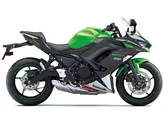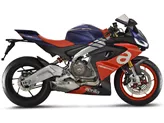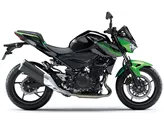Kawasaki Ninja 400 2023 vs. Honda CBR650R 2021

Kawasaki Ninja 400 2023

Honda CBR650R 2021
Overview - Kawasaki Ninja 400 2023 vs Honda CBR650R 2021
The Kawasaki Ninja 400 2023 and the Honda CBR650R 2021 are both popular supersport motorcycles that offer impressive performance and features. Let's compare these two models in terms of their technical specifications and strengths.
In terms of engine and drive train, the Kawasaki Ninja 400 2023 is equipped with a 399cc in-line twin-cylinder engine that delivers 45 horsepower and 37 Nm of torque. On the other hand, the Honda CBR650R 2021 features a larger 649cc in-line four-cylinder engine that produces a more powerful 95 horsepower and 63 Nm of torque. The Honda CBR650R has a higher compression ratio of 11.6 compared to the Ninja 400's 11.5. Both bikes have 4 valves per cylinder.
When it comes to suspension, both motorcycles feature a telescopic fork front suspension and a swing arm rear suspension with a monoshock. The Ninja 400 has a 41mm diameter front suspension, while the CBR650R has a slightly larger 41mm diameter front suspension. Both motorcycles offer preload adjustment for the rear suspension.

Kawasaki Ninja 400 2023
In terms of chassis, both the Ninja 400 and the CBR650R have a steel frame. However, the Ninja 400 features a tubular frame, while the CBR650R has a twin-tube frame. The CBR650R has a slightly steeper rake angle of 64.5 degrees compared to the Ninja 400's 63 degrees. The CBR650R also has a longer wheelbase of 1450mm compared to the Ninja 400's 1370mm.
When it comes to braking, both motorcycles are equipped with advanced rider assistance systems such as ABS. The Ninja 400 features a single disc front brake with a diameter of 310mm, while the CBR650R has a double disc front brake with the same diameter. The CBR650R also features radial brake technology, which provides improved braking performance.
In terms of dimensions and weights, the Ninja 400 has a front tire width of 110mm and a rear tire width of 150mm, while the CBR650R has a slightly wider front tire width of 120mm and a significantly wider rear tire width of 180mm. Both motorcycles have 17-inch front and rear tire diameters. The CBR650R has a longer wheelbase of 1450mm compared to the Ninja 400's 1370mm. The CBR650R also has a higher seat height of 810mm compared to the Ninja 400's 785mm. The CBR650R is also heavier, with a kerb weight of 208kg compared to the Ninja 400's 168kg. Both motorcycles have a fuel tank capacity of around 14-15.4 liters.
Now, let's discuss the strengths and weaknesses of each motorcycle. The Kawasaki Ninja 400 2023 is praised for its good combination of stability and playful handling, making it a fun and agile bike to ride. It also has a robust and reliable appearance, giving riders confidence in its durability. The Ninja 400's engine is well-controllable and offers a wide usable rev range, providing power throughout the RPM range. Additionally, it offers a pleasant seating position for riders.

Honda CBR650R 2021
On the other hand, the Honda CBR650R 2021 boasts a resilient four-cylinder engine that delivers impressive performance. It also offers a comfortable seating position, allowing riders to enjoy long rides without discomfort. The CBR650R's chassis has been improved for 2021, enhancing its overall performance and handling. It also has a cool look that appeals to riders who value aesthetics. Furthermore, the CBR650R is easy to operate, making it suitable for both experienced and novice riders.
However, the Kawasaki Ninja 400 2023 has a limited space for larger pilots, which may not be as comfortable for taller riders. On the other hand, the Honda CBR650R 2021 has been criticized for its engine feeling sluggish below 8,000 revolutions, which may affect its low-end power delivery. Additionally, some riders find the CBR650R's LCD display to be old-fashioned in comparison to other modern motorcycles.
In conclusion, both the Kawasaki Ninja 400 2023 and the Honda CBR650R 2021 are impressive supersport motorcycles that offer unique features and performance. The Ninja 400 excels in stability, handling, and reliability, while the CBR650R stands out with its powerful engine, comfortable seating position, and improved chassis. Ultimately, the choice between these two models will depend on the rider's preferences and priorities.
Technical Specifications Kawasaki Ninja 400 2023 compared to Honda CBR650R 2021
Pros and Cons in comparison
Pros and Cons in comparison
Kawasaki Ninja 400 2023

The Ninja 400 offers a lot of riding fun at a manageable price. It offers playful handling without being nervous. The name "Ninja" is a bit of a mouthful, but the range of use is wider than you might think. It rides sportily, but also offers a good riding position for everyday use and touring.
Honda CBR650R 2021

The 2021 update of the Honda CBR650R solves the biggest problem of the previous year's model: the overly comfortable chassis. The new Showa fork gives the sports bike a much sportier response, which is immediately noticeable on winding country roads. However, one should not expect a thoroughbred super sports bike, but a road sports bike suitable for everyday use, on which one can experience a lot of pleasure in the saddle both on the way to work and on a weekend ride.
Price Comparison Avarage Market Price Kawasaki Ninja 400 vs Honda CBR650R
There are a few key differences between a Kawasaki Ninja 400 2023 and a Honda CBR650R 2021. There are the same number of bikes of both models available on the 1000PS.de marketplace, specifically 73. It takes less time to sell a Honda CBR650R with 81 days compared to 165 days for the Kawasaki Ninja 400. Since model year 2018 1000PS.de editors have written 9 reviews for the Kawasaki Ninja 400 and 14 reviews for the Honda CBR650R since model year 2019. The first review for the Kawasaki Ninja 400 was published on 22/11/2017 and now has more than 44,300 views. This compares to more than 53,700 views for the first review on Honda CBR650R published on 08/10/2018.






















